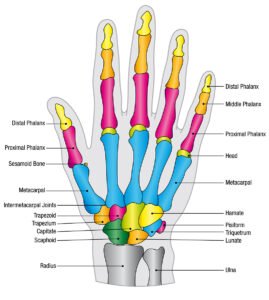By Eva Briggs, MD
 I recently started a new hobby, learning to play guitar.
I recently started a new hobby, learning to play guitar.
This requires a lot of hand dexterity and coordination, possible only because of the amazing structures that form our hand.
The framework consists of 27 bones. Eight carpal bones — arranged in two rows in the wrist — lie between the forearm and palm. For the curious, the names of the bones are as follows. In the proximal (closest to the forearm) row, from lateral (pinky side) to medial (thumb side): scaphoid, lunate, triquetrum, pisiform. In the second more distal (closer to the hand) row from lateral to medial: trapezium, trapezoid, capitate, hamate.
The carpal bones are arranged in an arch. The open side of the arch is connected by a membranous band called the flexor retinaculum forming a space called the carpal tunnel.
The palm of the hand contains five metacarpal bones, one for each digit. They’re numbered 1 (thumb) through 5 (pinky). It turns out this is where guitar playing requires code-switching. Guitarists use numbers 1 -4 starting at the index finger because musicians usually don’t fret with their thumbs.
The fingers contain small bones called phalanges. Two in the thumb and three in each finger. That adds up to 14 more bones.
These bones bend and move with the help of tendons, fibrous cords similar to a rope, which attach bones to muscles. Flexors bend the joints and extensors straighten the joints. Flexor digitorum profundus tendons bend the index, middle, ring and small fingers at the fingertips. A single common muscle divides into four tendons that run through the carpal tunnel, through tendon sheaths, to connect to the fingertip bones. The word profundus means deep, and these tendons run closest to the bone.
Flexor digitorum superficialis tendons bend the index, middle, ring and small fingers at the middle joint. A single forearm muscle divides into four tendons which travel through the carpal tunnel and then glide inside tendon sheaths. At the level of the fingers, these tendons each split into two separate cords. One attaches on either side of the flexor digitorum profundus tendon that is on its way to the fingertip.
Several extensor tendons straighten the fingers. The extensor digitorum communis tendons originate in the forearm and travel to the index, middle, ring, and small fingers. The small finger has an additional extensor digiti minimi tendon. The index finger too has an additional tendon, the extensor indicis proprius.
The thumb has its own tendons. The abductor pollicis longus tendon pulls the thumb away from the hand. It works alongside the extensor pollicis brevis. When these two tendons become inflamed it’s called DeQuervain’s syndrome. The flexor pollicis longus bends the thumb. The extensor pollicis longus straightens the thumb.
And there are additional tendons that control wrist motions! All those tendons make act like strings of a marionette, but something has to control them. That’s your brain, sending signals through various nerves. The three main nerves are the ulnar, median, and radial nerves.
The ulnar nerve travels from the neck, under the collarbone, through the armpit, and down the inside of the arm to the inner elbow. The ulnar nerve then travels on the inside of the forearm to the hand. It’s near the surface at the elbow and easily bumped, producing the tingling commonly called “hitting your funny bone.” The ulnar nerve controls many hand muscles and provides sensation to the small finger side of the hand. If the ulnar nerve is cut, the small and ring fingers curl into a claw shape and the hand becomes weak.
The radial nerve runs from the neck, around the humerus (upper arm bone), and down the forearm. Due to the proximity to the humerus, it can be injured if the humerus is broken. The radial nerve straightens the wrist and fingers. If damaged it can cause wrist drop – inability to straighten the wrist. This nerve also provides sensation to the thumb side of the back of the hand.
The median nerve supplies many forearm muscles controlling various wrist movements including bending the wrist as well as powering most of the finger flexors. It passes through the carpal tunnel and if compressed there can lead to carpal tunnel syndrome.
So how can a doctor keep track of all this? Most of us can’t — I had to look up what I couldn’t remember to refresh my anatomy class memories.
That’s why there are hand surgery experts: orthopedic surgeons or plastic surgeons with special training. And it takes a lot of training. For orthopedics it’s four years of college, four years of medical school, five years of residency in orthopedics, and one year of fellowship training. That’s 14 years after high school! After that there are both written and oral board exams. Plastic surgeons undergo similar training.
As an urgent care physician, part of my job is to recognize when a patient needs the advanced skills of a hand surgeon. Well, time to go practice my guitar now!
 Eva Briggs is a retired medical doctor who practiced in Central New York for several decades. She lives in Marcellus.
Eva Briggs is a retired medical doctor who practiced in Central New York for several decades. She lives in Marcellus.

